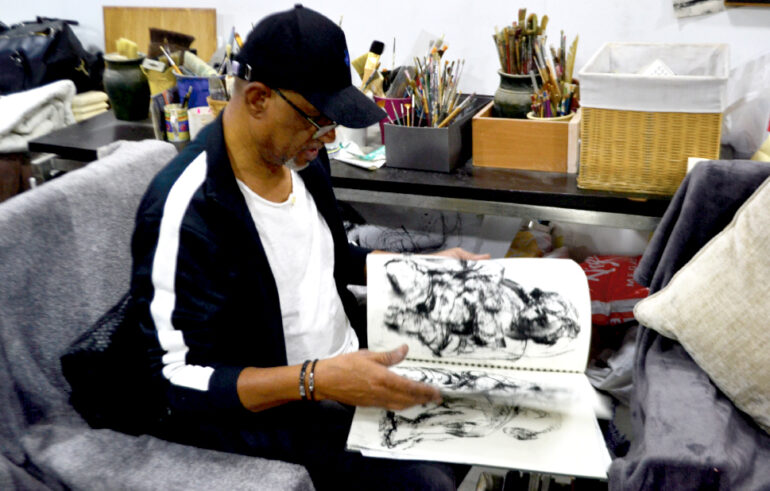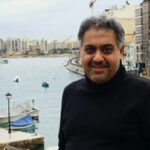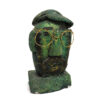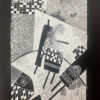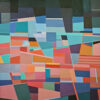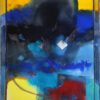Artist Abdul Rahim Salem, born in Dubai in 1955, is one of the pioneers of contemporary art in the UAE, and he is one of the most vibrant and productive artists. He graduated from Cairo University with a Bachelor of Fine Arts, majoring in Sculpture, in 1981. He is also a member of the Emirates Fine Arts Society and was a member of its board of directors for several sessions. He held many solo exhibitions and participated in most of the Society’s public exhibitions since 1981. He also participated in the first (Al-Banoosh) exhibition in 1983 and the second in 1984, the ninth Exhibition of Arab Fine Artists in Kuwait in 1985, the National Arts Festival in Sharjah in 1985, and the exhibition ( Negative and Positive) in Dubai in 1983, and (One Day) exhibition with the artist Hassan Sharif in Al Mareija area in Sharjah 1985, Sharjah Biennial 2001, Cairo Biennial 1988, 1992 and 1995, Bangladesh Biennial 1995, at the Abu Dhabi Cultural Foundation 1998, in the exhibition of the UAE pavilion at (Expo Hanover) ) in Germany 2000, in addition to many other exhibitions and art galleries. During his long artistic career, he won several awards, including the Golden Palm for the exhibition of artists of the Gulf Cooperation Council countries in 1992, the Jury Award for the Cairo Biennale 1992, the Silver Award at the Sixth Bangladesh Biennale for Asian Artists 1993, Al Dana Award at the 1994 Kuwait International Exhibition, the State Appreciation Award for Fine Arts 2008, and many others, until he was named in the local area as (the award reaper artist).
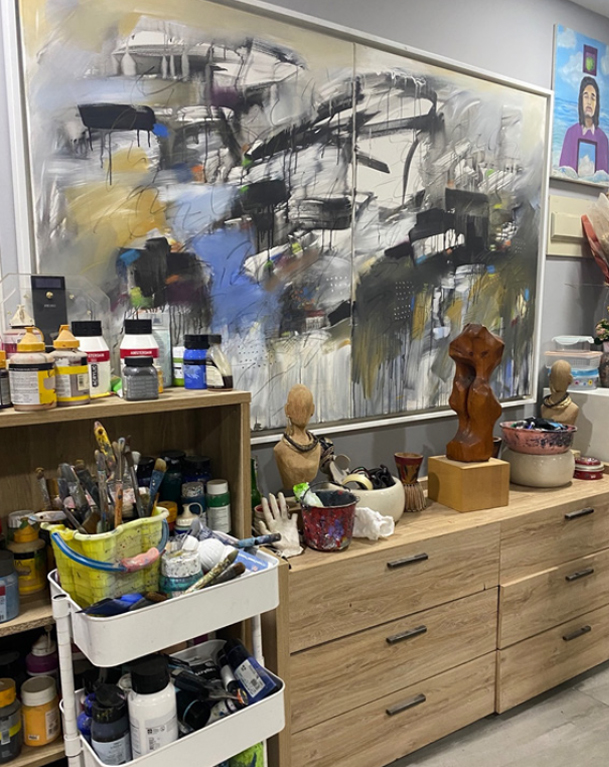
The artist Abdul Rahim Salem had many and various experiences in the world of sculpture. His sculptural works were mostly distinguished for his diverse choices of materials, and also for diverse methods, such as gypsum molding, wood engraving, hammering on copper plates, and engraving metal papers (Silver paper), and aluminum molding (Casting), and so on. It is noticeable that many of these works represent, either face (portraits), carved in an expressive style, or (figures) of small sizes, carved with pure abstraction in style. In addition, Abdul Rahim produced some sculptural installations, or pure abstract sculptures like the sculpture (Time and Fertility), but the late Emirati artist, Hassan Sharif, considered it a constructive installation, for reasons we can’t go into now. Anyway, this diversification in the materials of works and methods of formation, clearly indicate the artist’s active capacity, and his desire to experiment, utilize various materials, test the artwork texture, and work on both levels of sculpture; the three-dimensional, and the two-dimensional which is called Relief, and revive the spirits of expression and abstraction, both at the same time, or swing between them.

The relationship between size – and the conglomerates it may have – and space; is the basis for evaluating and measuring the impact of the sculptural form. However, we find that the light effects might sometimes have additional value in the sculptural works of Abdul Rahim Salem. As I noticed he formed some of his sculptors in a way that allows them to summon the features and benefits of lights, in an attempt to generate visionary connotations of shadows and luminous spots on the surface of the sculpture, using a method of an expressive nature in designing the composition and shaping the volume.
This – in my opinion – approaches the method of Auguste Rodin, the French sculptor, in the way he views the issue of light in sculpture, which is an approach that utilizes the features of light and shadow in painting as well. That is, in the impressionist style, and this may be more evident in expressionism sculpture, but Expressionism, with all of its importance and vitality, is rare in Emirati sculpture. Although, it was widespread in the art of painting, as in the paintings of the artists Mohammed Al-Mazroui and Mahmoud Jameel Al-Ramahi, who kept using this method for a long time. As well as in many paintings by the two artists Fatma Lootah and Salma Al-Marri. In addition to some paintings by the artists Obaid Suroor and Abdul Rahman Zainal. Despite all of this, among the rare Emirati expressive sculptures is a work by Abdul Rahim Salem, a colored gypsum product entitled (Explosion of a Face), size: 36 x 25 x 29 cm, produced in 1978. This artwork represents a human face (Portrait) in an emotionally explosive state between shadows and light, in which the muscles and tissues of the face are pulled downwards as if the face is melting after the explosion.
But this was not a basic style of Abdul Rahim Salem in the rest of his sculptures. Pure expressionism will gradually disappear in his sculptures to reach a brief-expression, or a general suggestion like in his sculpture (Dancers), which is executed from wood, size: 61 x 19.5 x 19. cm, production 1982. His sculptures will also reach semi-abstraction with his sculpture (Seated Woman), aluminum and marble, size: 36 x 17 x 17 cm, production 2001; in this work the effect of volume escalates in the void from the bottom up. The void in this work presses on the center of the sculpture from two sides, i.e. on the middle of the woman’s person, for the void is stronger in this position, and the size or form of the work is stronger at the top, as the sides of the sculpture – the head and arms – penetrate the void at the top is an indication of desire in emancipation and confronting the absolute, which is represented here by the void itself. In general, I see that the sculptures of the artist Abdul Rahim Salem ranged in significance from expressionism to semi-abstract, and also to pure abstraction in rare cases, but the combination of expression with abstraction remains the most prominent feature in his sculptural works, and this style will appear more clearly in relief sculptures.
In Relief sculpture, Abdul Rahim Salem appears to be more of a sculptor to me, as he paid much attention to the texture of the work, which reflects the texture of the material and the texture of his work on the sculpture as well. By that, I mean the traces of excavations or hammering, and so on. It is a special value of sculpture that was not available for the paintings back in the time. We see this clearly in its large relief sculpture executed by hammering on copper (Waiting for a Woman), size: 183 x 92 cm, production 1986, which represents a person clothed with one hand holding the other while he is in a state of waiting. This work – for me – is one of the most outstanding sculptural works of the artist Abdul Rahim Salem. It is a work that speaks multiple connotations and indicates an extraordinary ability for the artist to employ the person within an aesthetic unit that depends on the repetition of the effects of hammering, repeating the lines and twists of the body, and the twists of the mantle that wraps him. The material chosen for the execution of this work – which is copper – has added to the work a mysterious and controlling fear.

Abdul Rahim Salem produced several works in this style, but they varied in size, and one of them was of a different material, gypsum, and I think that each of them has its own unique inspiration that is not found in other Emirati sculpture works. Abdul Rahim Salem’s experience in relief sculpture will not be limited to medium or large works, but will go beyond that to some nice small works, which reminds me of the words of the Swiss sculptor Alberto Giacometti: “The smaller the sculpture; It seemed more sculptural to me.”
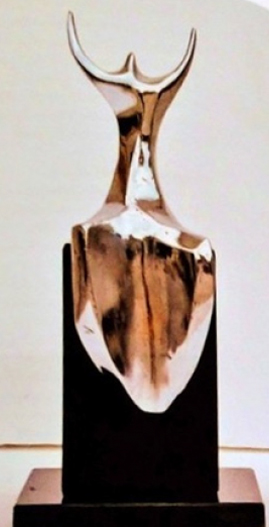
In 1987, Abdul Rahim Salem made a group of small-sized works that could be considered relief sculptures. He produced them by engraving them on silver paper and displayed them in a personal exhibition in the same year in the hall of the Emirates Fine Arts Society. I was unable to attend the exhibition, but I saw some of these works in 1988 hanging on the wall of the Emirates Fine Arts Society. I liked them very much, watching them was an intimate experience for me, as it reminded me of my school days in elementary school when we were learning engraving on metallic paper in the art education class. I thought it was restricted to children in schools, and that is why I was impressed by those small works produced by Abdul Rahim. I wished that he would continue to produce and develop such works that are unique in nature in the field of visual arts in the Emirates. As no other professional Emirati artist was working on engraving on metallic paper; the uniqueness of the artist Abdul Rahim Salem in this has great artistic value in my view.
Emotions and suggestive feelings were present in the subject composition of those small figures. As the figures or the subject’s elements protruded from the surface of the metallic paper – which is the background of the work – in small sizes interconnected by juxtaposition, and semi-contact in an indication of a relationship. As some anxious lines were surrounding those characters and elements. These lines came either to define the shapes in the composition, or to create limited, vague, and sometimes suggestive expressions around the elements of the composition to give them a bit of vitality. The color was a major factor in inspiration as well, each sheet of metallic paper that Abdul Rahim Salem chose for these works had a special color, such as green and blue, and so on. The artist – after engraving the elements of the artistic composition to highlight them on the surface of the metallic paper – dilutes the color of the protrusion places using a thinner liquid that causes the color added artificially to recede. This happens gradually from the prominent elements to the borders of the sunken background, where the relief stops to show the prominent elements shining in a semi-silver color after the original color has receded. As for the background in which the original color remained, it seemed cloudy in comparison with the prominent places, which seemed vague in their dimension as well. This has created an interesting kind of suggestion of the approach of the subject and the distance of the background. Also, in the details of the subject itself, I see that clarity and ambiguity go hand in hand by combining expression and abstraction in characters and others. In general, these small works were distinguished, in my opinion, by their kindness and charming elegance.
The foregoing may indicate the presence of Expressionism in these works, and there is no doubt that they were expressive in some way as I saw them thirty-four years ago.
However, the presence of abstraction in them was also clear, as the characters in the work were not based on clear representation, rather it was mostly blurry, as I mentioned. The artist Hassan Sharif described the artistic style in these Abdul Rahim’s works as semi-abstract as I heard it myself, and this is true, but this means that it was almost expressive as well. This is what encouraged me repeatedly to describe it as one of the promising experiences of expressive abstraction in the future of artistic production for Abdul Rahim Salem, or that it was pushing him to take expressive abstraction as a method.

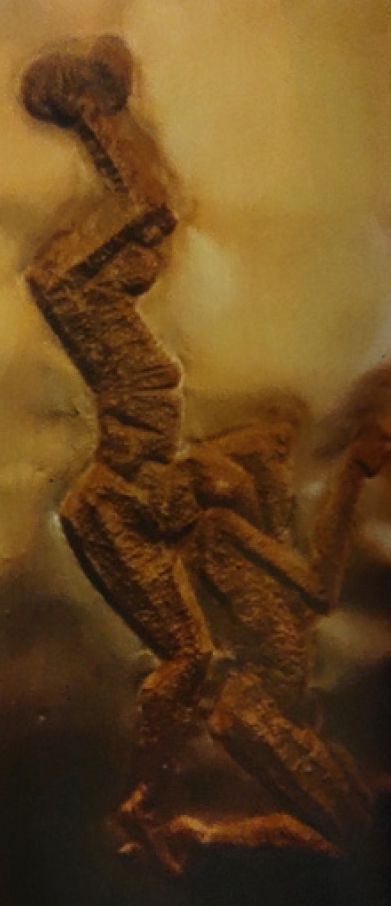
This is what happened in fact, at the end of the eighties, we witness the production of several paintings in which he came very close to the style of the expressive abstract school. That school was described by some critics in the West as “the end of the possible in art”. Maybe because it includes both expression and abstraction, or personification and non-personification in a single work. This gives the artist great freedom to approach the subject, composition, and the rest of the elements of the work. Perhaps this is what Abdul Rahim Salem was looking forward to during his research and experimentation with artistic methods. Then he started to produce many paintings in this context, which negatively affected his sculptural production, causing it to reduce or stop for many reasons that cannot be considered in this brief article.
A researcher for knowledge, visual artist, art critic, poet, musician, and director of the Artistic Heritage Department at Sharjah Institute for Heritage.

